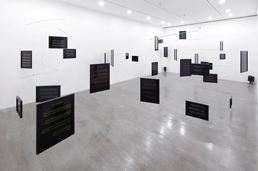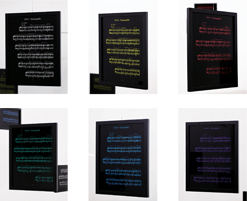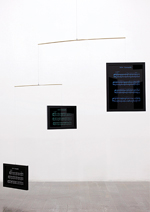night passage
2011
Sound Installation
metallic color ink, acrylic board, wooden flame, stainless steel, blass stick, wire, powered speakers, sound
dimensions variable
Contemporary Art Center, Art Tower Mito, Ibaraki, Japan
The woods of memories are shaking.
This moment as 'present' is continuation with depth which repeats expansion and contraction. In other words, a relation to innumerable events in the past contracts into a point of the present, and to regard the (series of) relationships between the present and the past as 'now' would give the 'present' a certain depth. Other countless events of the past which have not been included in the 'present' with the depth also remain the possibility that they would become 'now', and therefore several time-axes exist parallel. I weave the countless fragments of '3 Gymnopedies' of Erik Satie into the sound of 'night passage' which has the depth with continuation. Some of them can be heard whereas the others cannot be heard. Will the 'Gymnopedie' be recollected as dejau through a relation to its musical phrases which can be heard fragmentarily?
The Tone of Chaos, The Sound of an Omen
Mizuki Takahashi
Curator, Contemporary Art Center, Art Tower Mito
Erik Satie is known as the composer who first introduced the concept of eFurniture Musicf that would melt into the time and space in our daily lives, and has influenced subsequent ambient and easy listening music.For this exhibition Yoichi Kamimura, who has been creating works primarily concerned with sound and music translated into a visual language, presents a new work in which he has rearranged Satiefs masterpiece Gymnopedies with sound and visual expressions, using specific techniques such as the remix, cut-up and mash-up.
@There is no doubt that the clear melody of Gymnopedies seamlessly melts into our daily lives. Or rather, if a peaceful, everyday life could be transformed into great music, it may very well sound something like this. However, Kamimurafs work has transformed Gymnopedies to such an extent that it is almost impossible to recognize even a trace of the original.
@To begin, Kamimura cut the score of the Gymnopedies into individual bars of music. Utilizing the chance operation system that John Cage once experimented with, the artist rolled a six-sided dice for the each bar, and classified them into groups numbered 1 to 6 according to the roll. He then combined the bars from each group into a single score, resulting in the production if six completely new scores. The scores hung as mobiles are in fact the song Gymnopedies after being deconstructed and consequently reconstructed through this process of chance operation. Playing over the speakers are the six new versions of Gymnopedies that the artist rearranged and remixed, with additional effects on the tempo and tone. Divided by the random numbers of a dice, it might be said that the distorted and dissonant sounds of this new version of Gymnopedies are a kind of ambient music that expresses everyday life after the Great Tohoku Earthquake of 11th March 2011, when the ordinary peace and tranquility of many peoplefs lives came to an end. Kamimura is interested in the psychological effects of sound on people, and it is certain that while this dissonant version of Gymnopedies resonates with the swinging of the mobiles, it also arouses a sense of anxiety.
@The earthquake in March seems to have deeply affected the artist, who had never made a social issue the direct theme of his work in the past. Coming face to face with this collapse of the stable norm, Kamimura and many other artists like him spent day after day agonizing over the meaning of creating art, and how his own work should be. The present work emerged from such reflection, and looking directly into the fact that in this suspended reality nothing has yet been solved.
@If you look at the work carefully, however, you realize that it is not merely a gloomy, pessimistic take on the current state. Although the mobile hanging from the ceiling moves unpredictably, it actually has a flexible, strong structure that can avoid collapse by moving with the building in the event of an earthquake. To me, the swinging yet dignified mobile made of musical scores seems to be Kamimurafs reaction to the unstable condition of the present, and his modest determination to live with art. At the same time, I also see it as a scale to measure the ethics of our actions moving forward. Experiencing this work again several years from now, I wonder if we will be able to recall the tone of the chaos that gave birth to this dissonant version of Gymnopedies, or if we will listen to it as the ambient music of a disquieting time. The black musical scores swinging in the space above do not yet have an answer.
@@@
2011
Sound Installation
metallic color ink, acrylic board, wooden flame, stainless steel, blass stick, wire, powered speakers, sound
dimensions variable
Contemporary Art Center, Art Tower Mito, Ibaraki, Japan
The woods of memories are shaking.
This moment as 'present' is continuation with depth which repeats expansion and contraction. In other words, a relation to innumerable events in the past contracts into a point of the present, and to regard the (series of) relationships between the present and the past as 'now' would give the 'present' a certain depth. Other countless events of the past which have not been included in the 'present' with the depth also remain the possibility that they would become 'now', and therefore several time-axes exist parallel. I weave the countless fragments of '3 Gymnopedies' of Erik Satie into the sound of 'night passage' which has the depth with continuation. Some of them can be heard whereas the others cannot be heard. Will the 'Gymnopedie' be recollected as dejau through a relation to its musical phrases which can be heard fragmentarily?
The Tone of Chaos, The Sound of an Omen
Mizuki Takahashi
Curator, Contemporary Art Center, Art Tower Mito
Erik Satie is known as the composer who first introduced the concept of eFurniture Musicf that would melt into the time and space in our daily lives, and has influenced subsequent ambient and easy listening music.For this exhibition Yoichi Kamimura, who has been creating works primarily concerned with sound and music translated into a visual language, presents a new work in which he has rearranged Satiefs masterpiece Gymnopedies with sound and visual expressions, using specific techniques such as the remix, cut-up and mash-up.
@There is no doubt that the clear melody of Gymnopedies seamlessly melts into our daily lives. Or rather, if a peaceful, everyday life could be transformed into great music, it may very well sound something like this. However, Kamimurafs work has transformed Gymnopedies to such an extent that it is almost impossible to recognize even a trace of the original.
@To begin, Kamimura cut the score of the Gymnopedies into individual bars of music. Utilizing the chance operation system that John Cage once experimented with, the artist rolled a six-sided dice for the each bar, and classified them into groups numbered 1 to 6 according to the roll. He then combined the bars from each group into a single score, resulting in the production if six completely new scores. The scores hung as mobiles are in fact the song Gymnopedies after being deconstructed and consequently reconstructed through this process of chance operation. Playing over the speakers are the six new versions of Gymnopedies that the artist rearranged and remixed, with additional effects on the tempo and tone. Divided by the random numbers of a dice, it might be said that the distorted and dissonant sounds of this new version of Gymnopedies are a kind of ambient music that expresses everyday life after the Great Tohoku Earthquake of 11th March 2011, when the ordinary peace and tranquility of many peoplefs lives came to an end. Kamimura is interested in the psychological effects of sound on people, and it is certain that while this dissonant version of Gymnopedies resonates with the swinging of the mobiles, it also arouses a sense of anxiety.
@The earthquake in March seems to have deeply affected the artist, who had never made a social issue the direct theme of his work in the past. Coming face to face with this collapse of the stable norm, Kamimura and many other artists like him spent day after day agonizing over the meaning of creating art, and how his own work should be. The present work emerged from such reflection, and looking directly into the fact that in this suspended reality nothing has yet been solved.
@If you look at the work carefully, however, you realize that it is not merely a gloomy, pessimistic take on the current state. Although the mobile hanging from the ceiling moves unpredictably, it actually has a flexible, strong structure that can avoid collapse by moving with the building in the event of an earthquake. To me, the swinging yet dignified mobile made of musical scores seems to be Kamimurafs reaction to the unstable condition of the present, and his modest determination to live with art. At the same time, I also see it as a scale to measure the ethics of our actions moving forward. Experiencing this work again several years from now, I wonder if we will be able to recall the tone of the chaos that gave birth to this dissonant version of Gymnopedies, or if we will listen to it as the ambient music of a disquieting time. The black musical scores swinging in the space above do not yet have an answer.
@@@



